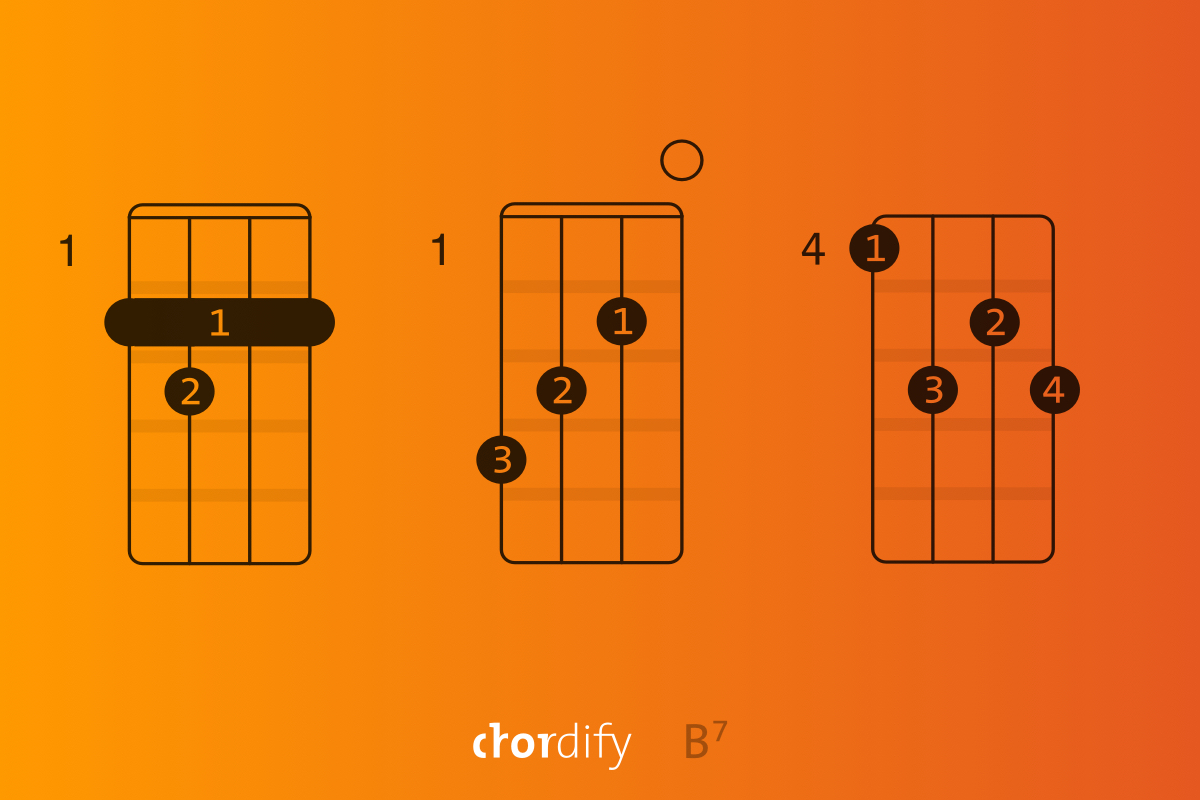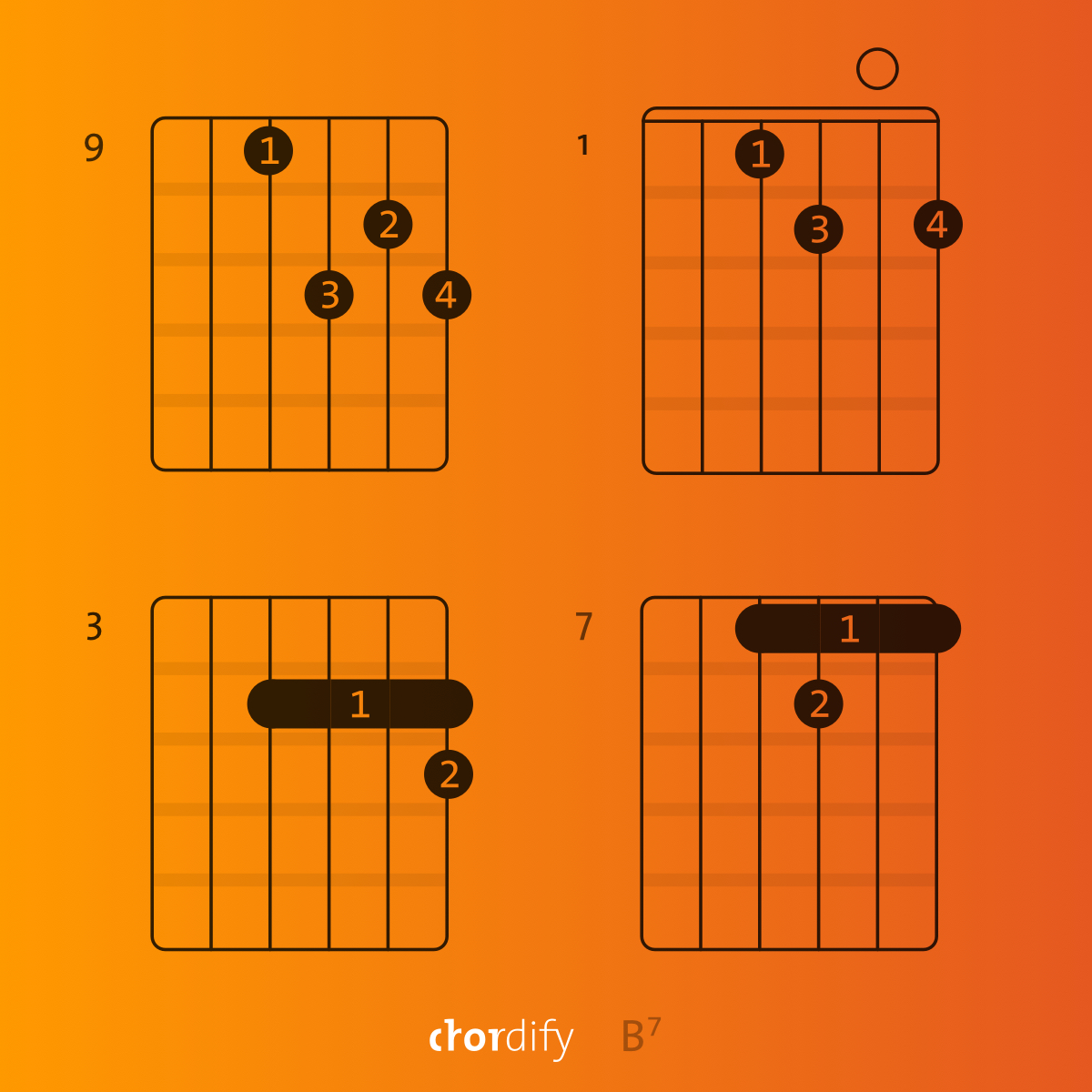How To Play B7 On Ukulele
Do you want to play a B7 chord on pianoforte, guitar or ukulele? You came to the right place. In this blog post we will show yous different ways of executing this chord on your musical instrument of choice. Starting with chord shapes on piano, guitar and ukulele, and wrapping it up with some music theory showing you the basic elements that make up the B7. Ready to beef up your music muscle?
Main takeaway from this article
This commodity focuses on how to play the B7 chord on pianoforte, ukulele and guitar. But that'south not all we want to prove y'all. I of the main lessons is: In that location are multiple ways of playing the same chord.
The rules of music theory prescribe how a chord can be played; that's why you can play effectually on the fretboard and behind the keys. Start, we'll show you three different means of playing a B7 chord on different instruments—if you lot can't look, simply scroll down and check out the chord diagrams. Once you lot've processed those, yous'll accept a pretty good sense of how to play the B7 chord.
After that, yous have a choice. Either you apply your new knowledge and beginning jamming or, if you're curious, read on to learn nearly the different inversions of the chord and a little music theory.
B7 chord on pianoforte
There are many ways of playing the aforementioned chord. Just take a look at the chord diagrams below; these 3 figures represent the aforementioned chord. If you play them as a beginner, information technology'south very plausible to think that they audio different. But they are all variations of the B7 chord on piano. So, how is that possible?

B7 chord on piano
Nosotros'll explicate later. First, let's take a look at the chord diagrams. Endeavour it out on your keyboard and listen carefully to every chord. They all have this jazzy/bluesy vibe, don't they? That is totally truthful because the B7—like nearly of the 7 chords—is used to give songs a warm, dreamy, melancholic feel. Check out our "Songs Explained" series with "Everything I Wanted" by Billie Eilish; that track is living proof of how dreamy 7 chords can get.
Ukulele chords B7
On ukulele the B7 chord looks like this: Position your index finger on the 2d fret and barre all four strings; after that, position your eye finger on the tertiary string third fret. Well, that's what a B7 chord sounds like on the ukulele.
But what happens when we finger the 2nd, third and fourth fret starting at the 2d string? Check out the second chord diagram beneath and don't forget to play the kickoff open string besides. It may sound a flake dissimilar than the other chord, but this is likewise a B7 chord.

B7 chord on ukulele
The 3rd chord diagram in the picture is the final B7 we'll show you. Jump on the quaternary fret and endeavor it out, and meet if y'all can hear the feature sound of the B7 chord. Position your index finger on the fourth string fourth fret, your band finger on the 3rd string 6th fret, your center finger on the 2nd string fifth fret, your pinky on the beginning string sixth fret, and give this shape a good ring. Congratulations! This is a tertiary fashion of playing a B7 chord on ukulele.
B7 guitar chord
A B7 chord on guitar is a bit unlike than on the ukulele. Since both instruments are tuned in a different manner, it won't come as a surprise that the chord shape for the B7 on guitar isn't the aforementioned as on ukulele. If you want to play the B7 chord on guitar, in that location are a few ways to practice and then. Cheque out the chord diagrams beneath for the near common ways to play this chord.

B7 chord on guitar
The first chord diagram shows the B7 barre chord. In a barre chord you use i finger to press down more than 1 string on one fret—every bit you tin can see, this is the case in the first and 3rd chord diagram. The 2nd representation of the B7 is an open chord. Attempt them all out and feel the vibe that connects them.
Why tin we play the B7 chord in and then many ways?
Isn't it interesting that nosotros tin play the B7 chord in a lot of different ways on all three instruments? It reeks of magic. Think about information technology for moment, all those chord shapes have almost nothing in common, and they notwithstanding represent the same chord. Without a well-trained ear, you lot could mistake the sound of one shape for another.
And so, allow's hop on this roller coaster of music theory, shall we? Here's why you tin play the B7 chord in different ways without making it audio totally different.
Music theory behind B7
Each chord has a calibration that describes that chord. In order to "communicate" with this chord, information technology's very of import to know this scale. Let'south take a closer look at the scale for B7: B (root), C#, D# (third), E, F# (fifth), M#, A (7th).
Practise y'all call back the skeleton for basic chords? Need to brush up? Read our blog "How to play a B chord explained in three simple steps." Correct, the skeleton consists of the root, the third and the fifth. In our case the skeleton is: B, D# and F#.
To brand the chord "spicier" or to "broaden" the audio, nosotros add the seventh—the 7th note of the calibration. The skeleton now consists of four notes: B (root), D# (third), F# (fifth), A (7th)—remember this order by the way. These are the verbal same notes that y'all play on pianoforte, ukulele or guitar; as we already showed you in the previous chord diagrams.
Explore different combinations
At present, let's talk sports for a bit (yeah, sports). Imagine existence the coach of a sports team that is participating in a race. Your team consists of iv players: Root (R), Tertiary (3), Fifth (v), Seventh (7). They are running in this gild: R, 3, 5, 7. Simply sometimes, depending on the situation, you can modify the gild of your players: [3, 5, 7, R] or [5, 7, R, three] or [seven, R, 3, v].
In music these are called inversions. The B7 chord has iv notes (players); therefore, it tin have three inversions. So, our initial order is: B, D#, F#, A. The beginning inversion is: D#, F#, A, B. The second inversion is: F#, A, B, D#. And the third inversion looks like this: A, B, D#, F#. Which i yous tin employ depends on the situation.
When to use inversions
What kind of situations are we talking nearly? Simply put: Inversions are a slap-up style of avoiding jumping effectually on the fretboard on guitar or ukulele. The same goes for the pianoforte keyboard; y'all avoid leaping from one end to another.
When you take to play the same chord for a longer fourth dimension, inversions offer some other neat reward. In this instance, they allow you to embellish your playing by calculation breadth to the sound. Whatever yous do with them, these kinds of cool techniques are a great add-on to your skillset.
B7 inversions on guitar
Since you lot're still here, it means that you lot cannot wait to learn how to play these inversions. The inversions on pianoforte are the same as discussed above under the heading "B7 chord on piano."
And what about guitar? Practiced question. There are many means of playing a B7 on guitar, depending on the string you're starting from. Here are some playable and friendly inversions for a B7 chord, played from the fourth string:

B7 chord inversions on guitar
Get out your instrument, wait at these inversions, and happy jamming!
Source: https://chordify.net/pages/b7-chord/



0 Response to "How To Play B7 On Ukulele"
Post a Comment